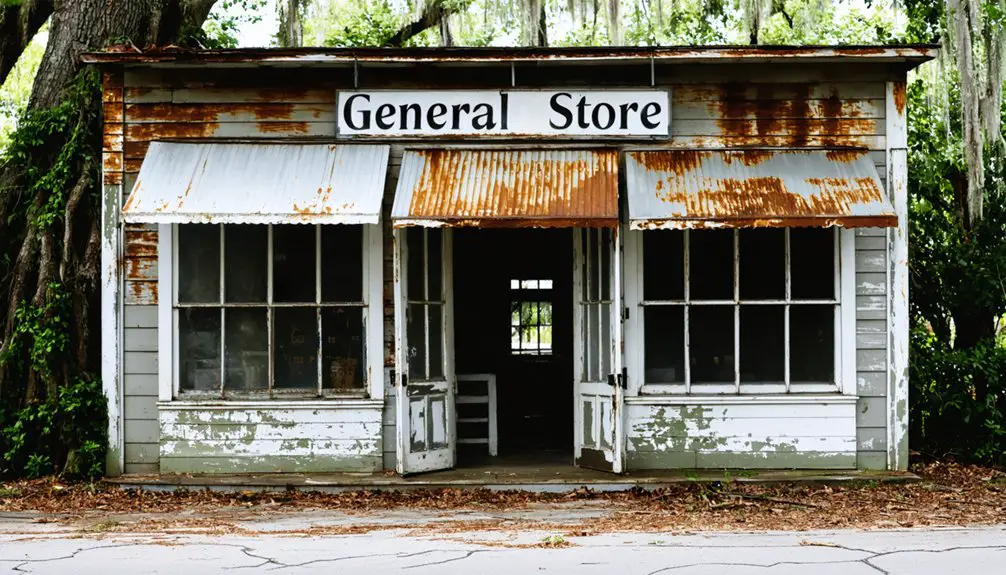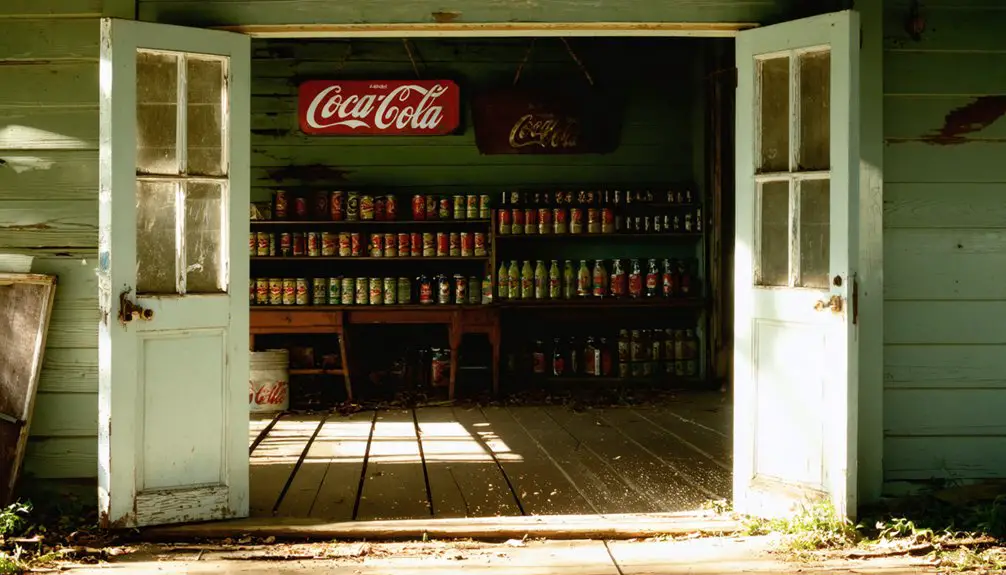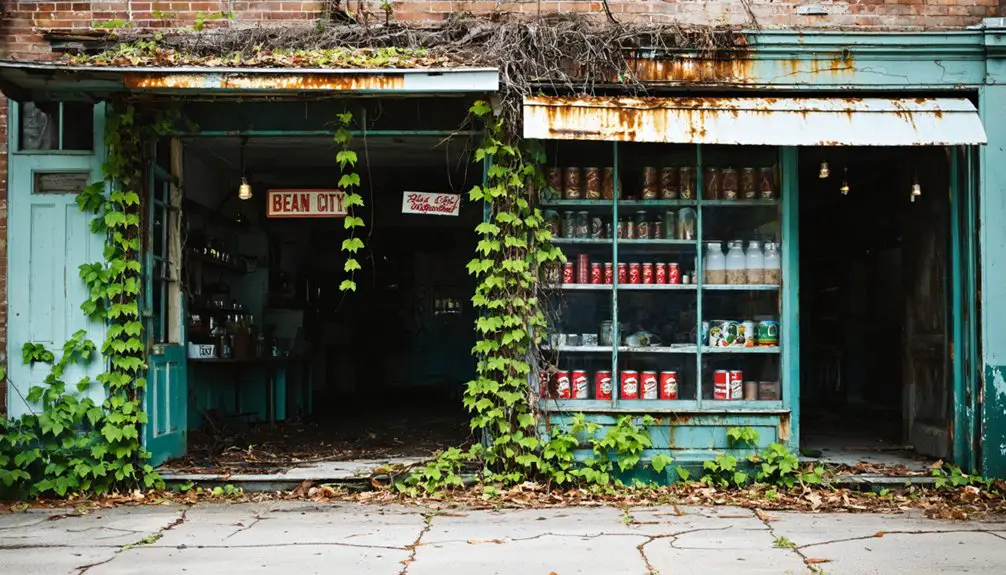You’ll find Bean City’s remains near Lake Okeechobee’s southern ridge, where a thriving agricultural community once flourished from 1916 to the 1970s. The town’s signature green bean crops and close-knit farming community were devastated by the catastrophic 1928 Okeechobee hurricane. Today, only six scattered houses and broken foundations remain among vast sugarcane fields, marking where pioneers William C. Hooker and Isaac H. Stone’s vision of an agricultural empire once stood. The site’s haunting ruins tell a deeper story of resilience and change.
Key Takeaways
- Bean City was established in 1916 near Lake Okeechobee as a farming community specializing in green beans and tomatoes.
- The devastating 1928 Okeechobee hurricane caused widespread destruction, with floodwaters up to 7 feet deep throughout Bean City.
- The town declined after the Bean City School closed in 1952 and the post office shut down in 1973.
- Only six scattered houses remain near the original townsite, with most of the area now converted to sugarcane fields.
- Broken foundations and rubble fields mark where this once-thriving agricultural community existed along Old US 27.
The Birth of a Bean-Growing Settlement
In 1916, an ambitious agricultural venture took root near Lake Okeechobee’s southern ridge when farmers and entrepreneurs established Bean City, Florida.
You’ll find its origins tied to pioneers like William C. Hooker and Isaac H. Stone, who spearheaded agricultural practices that would shape the community’s destiny. While tomatoes initially dominated the landscape, it’s the town’s signature crop – green beans – that ultimately gave this settlement its memorable name.
The founders strategically positioned Bean City along Old US 27 (Corkscrew Road), ensuring efficient distribution of their harvests. This smart placement fostered rapid community development as the agricultural hub flourished. The Bean City School opened its doors in 1923, serving the growing community of farmers and workers.
Each September, the fields would come alive with activity as workers arrived to plant the season’s crops, setting in motion a thriving economy that would sustain the town for years to come. The community’s prosperity came to an abrupt end when a hurricane in 1928 devastated the settlement.
Life in Early Bean City
Life in Bean City revolved around the rhythms of agriculture, where you’d find a close-knit community of farmers, merchants, and seasonal workers shaping their daily routines around the demands of bean cultivation.
Local businesses, including general stores run by settlers like Isaac H. Stone and Charles G. Price, served as both commercial hubs and gathering spots for the community. The town’s location near St. Andrews Bay provided crucial water access for agricultural transport. Similar to Can Town, the area had once housed a seafood canning operation.
The general stores of Bean City weren’t just places of commerce – they were the heart of community life and social connection.
You’d witness the town’s population swell each September when migrant labor arrived for the planting season.
The rural lifestyle centered on the intensive work of growing and harvesting green beans, which dominated the local economy from 1936 to 1973.
While environmental challenges like flooding constantly tested the residents’ resilience, they adapted to the seasonal patterns and built a community that, though temporary, left an indelible mark on Florida’s agricultural history.
The Devastating 1928 Hurricane
The catastrophic 1928 Okeechobee hurricane struck Bean City with devastating force, bringing 18 inches of rain and pushing Lake Okeechobee’s waters over the levees to create floodwaters up to 7 feet deep.
The hurricane maintained Category 4 intensity when it made landfall in Florida on September 17. The storm caused an estimated $25 million in damage across Florida.
You’ll find that nearly every structure in Bean City was either destroyed or severely damaged, with the flooding washing away thousands of acres of farmland and displacing the entire community.
While attempts were made to rebuild after the waters receded, the scale of destruction and loss of life—part of the estimated 3,000 total hurricane deaths—proved too overwhelming for Bean City to fully recover.
Impact On Local Infrastructure
When the devastating 1928 hurricane struck Bean City and surrounding areas, it wreaked unprecedented havoc on local infrastructure, destroying nearly 10,000 structures statewide and damaging over 22,000 more. As a Category 5 system, the hurricane brought unparalleled destruction to the region.
You’ll find that infrastructure resilience was virtually non-existent, as the storm overwhelmed critical systems throughout the region. Lake Okeechobee’s dikes failed catastrophically, sending floodwaters up to 20 feet high through Bean City and neighboring communities. The storm caused approximately $25 million in damage across Florida.
The disaster crippled transportation networks, with destroyed bridges and roads severely limiting emergency response.
You couldn’t even count on basic utilities – telephone service was cut to 32,000 households, with 400 poles broken and 2,500 leaning.
Community recovery efforts were hampered by extensive damage to public buildings, including schools and weather stations, while widespread flooding delayed reconstruction for weeks.
Death Toll And Displacement
As flood waters surged through Bean City in 1928, they claimed an unprecedented number of lives, with official Red Cross records initially documenting 1,836 deaths – though later studies by NOAA and historians would revise this figure upward to between 2,500 and 3,000 victims.
You’ll find the death statistics particularly sobering when you consider that about 75% of those who perished were migrant farm workers, many of whom couldn’t be identified.
Survivor accounts describe floodwaters rising at about an inch per minute as Lake Okeechobee‘s waters breached the inadequate 5-foot dikes. The massive storm surge of 10 feet overwhelmed the area around the lake.
The catastrophe left roughly 800,000 people homeless, with thousands seeking refuge in temporary shelters. The hurricane brought devastating 145 mile per hour winds that destroyed countless homes and buildings.
The devastation was so severe that many bodies had to be burned or buried in mass graves at sites like Port Mayaca and Woodlawn Cemetery.
Rebuilding Efforts Post-Storm
Following devastating losses of life and property, rebuilding efforts in Bean City and surrounding areas commenced under decisive leadership from local authorities.
You’ll find community resilience emerged through coordinated rebuilding strategies, as mayors ordered able-bodied citizens to join recovery efforts while temporarily suspending building permits for essential repairs.
- Over 3,000 building permits issued in West Palm Beach within 9 months
- Anti-price gouging laws enacted to maintain stable supply costs
- Improved building codes mandated stronger frames and wind-resistant materials
- Herbert Hoover Dike constructed for flood control
- New flood control infrastructure included floodway channels and control gates
These transformative measures reshaped construction practices across Florida, with lasting impacts on hurricane preparedness and structural resilience.
The region’s recovery demonstrated the power of decisive action and community-driven reconstruction efforts.
From Bustling Town to Abandoned Land

During its peak in the early 1920s, Bean City thrived as a bustling agricultural hub where string bean cultivation and vegetable packing operations drove the local economy.
Despite the community’s resilience after the devastating 1928 hurricane, persistent farming challenges would ultimately seal the town’s fate.
You’ll find that the transformation from vibrant town to abandoned land happened gradually. As sugar companies acquired more farmland, the traditional bean farming declined.
The school’s closure in 1952 marked the beginning of the end, followed by the post office’s shutdown in 1973.
Today, if you venture to Bean City’s former location, you’ll discover only swampy terrain, broken foundations, and dilapidated road segments along Old US 27 – silent witnesses to a once-prosperous farming community that time has nearly erased.
What Remains Today
Modern visitors to Bean City will find few traces of its former glory. The current remains of this once-vibrant community have largely given way to an agricultural landscape dominated by sugarcane fields.
You’ll encounter a deteriorating section of Old US 27, also known as Corkscrew Road, which now serves mainly farm traffic rather than townspeople.
- Only 6 scattered houses survive near the original townsite
- Broken foundations peek through swampy patches and rubble fields
- Agricultural workers have replaced the town’s former residents
- No intact public buildings or commercial structures stand
- The old town footprint has surrendered to nature and farming
The site’s transformation reflects the broader changes that swept through rural Florida, leaving Bean City’s physical legacy mostly erased by time, development, and the endless march of sugarcane rows.
Legacy and Historical Significance

Although Bean City exists today only as scattered ruins among sugarcane fields, its historical significance runs deep in Florida’s agricultural heritage.
You’ll find its story reflects the remarkable community resilience of early 20th-century farming settlements around Lake Okeechobee, particularly in how they faced natural disasters and economic changes.
The town’s evolution from a thriving string bean producer to a ghost town mirrors the broader transformation of Florida’s agricultural landscape.
Its experience during the devastating 1928 hurricane, followed by partial rebuilding and eventual decline, serves as a powerful reminder of both human determination and vulnerability.
The legacy of Bean City lives on through its contribution to the region’s farming history and its role in shaping modern agricultural practices in South Florida.
Frequently Asked Questions
What Crops Besides Beans and Sugarcane Were Grown in Bean City?
Like a colorful farm quilt, you’d find a patchwork of crops: watermelons, pumpkins, corn varieties, peas, and lettuce thrived through crop rotation, while bananas, grapefruit, and avocados dotted the landscape.
Were There Any Famous Residents or Visitors to Bean City?
You won’t find any famous visitors or notable residents in historical records – the community was primarily made up of local farmers, merchants, and migrant workers serving the agricultural economy.
How Much Did Land Cost in Bean City During Its Peak?
You won’t find exact land prices for Bean City during its peak, but the area’s historical economy suggests agricultural land values were moderate, based on farming potential for green beans and vegetables.
What Businesses and Stores Operated in Bean City Before Abandonment?
Bustling businesses in the historic buildings included Stone’s general store, Price’s market, Royal’s Lake Harbor Store, Harbin’s drugstore, four tomato packing houses, Bohannon’s garage, and a local light plant.
Did Any Native American Tribes Inhabit the Bean City Area Previously?
You’ll find Native tribes like the Timucua and later Seminole and Creek peoples inhabited this area, as evidenced by historical artifacts and archaeological sites dating back to around 100 BC.
References
- https://www.ghosttowns.com/states/fl/beancity.html
- https://palmbeachpast.org/2011/03/palm-beach-countys-lost-towns-the-complete-list/
- http://www.gribblenation.org/2018/08/ghost-town-tuesday-ghost-towns-of-lake.html
- https://commons.wikimedia.org/wiki/File:THE_END_of_the_Road_-_Ghost_Town_Bean_City_(50797582063).jpg
- https://en.wikipedia.org/wiki/List_of_ghost_towns_in_Florida
- https://en.wikipedia.org/wiki/History_of_West_Palm_Beach
- https://education.pbchistory.org/pbc_community/bean-city/
- https://www.annamariaislandinn.com/blog/the-history-and-heritage-of-anna-maria-island-florida/
- https://fcit.usf.edu/florida/docs/b/baycounty.htm
- https://stluciehistoricalsociety.net/19th-early-20th-century-communities/



